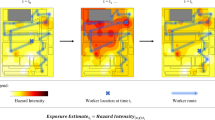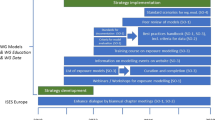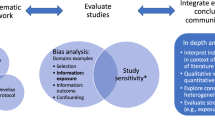Abstract
The objectives of this study were to determine the heterogeneity of data sources used to construct a job-exposure matrix (JEM) for occupational noise, and to calculate pooled exposure estimates for different job titles using different sources. The JEM was populated with measurements from government databases, private industry, and the published literature. Data were organized by job title using the US standard occupational classification (SOC). Using data from the literature as prior information, adjusted mean exposure was calculated for both the government and industry data following a simple Bayesian approach. A meta-analysis was conducted to measure data heterogeneity across sources and to calculate a pooled exposure estimate for each SOC and SOC group. In total, 715,867 measurements across 259 SOCs were analyzed. Using the data from literature as a prior, 15 of 28 applicable SOCs in the government and industry data had adjusted mean exposures above the OSHA action level (85 dBA). The meta-analysis showed that 63% of SOCs, and 78% of SOC groups, had moderate to high heterogeneity. Fifty-one percent of SOCs and 43% of SOC groups had pooled estimated exposures >85 dBA. The pooled estimates suggested that workers in 131 of 259 SOCs (51%) were exposed beyond the threshold of 85 dBA.
This is a preview of subscription content, access via your institution
Access options
Subscribe to this journal
Receive 6 print issues and online access
$259.00 per year
only $43.17 per issue
Buy this article
- Purchase on Springer Link
- Instant access to full article PDF
Prices may be subject to local taxes which are calculated during checkout




Similar content being viewed by others
References
NIOSH. Criteria for a Recommended Standard Occupational Noise Exposure Revised Criteria 1998. National Institutes of Occupational Safety and Health 1998.
Tak S, Davis RR, Calvert GM . Exposure to hazardous workplace noise and use of hearing protection devices among US workers—NHANES, 1999-2004. Am J Ind Med 2009; 52: 358–371.
Basner M, Babisch W, Davis A, Brink M, Clark C, Janssen S et al. Auditory and non-auditory effects of noise on health. Lancet 2014; 383: 1325–1332.
Talbott EO, Gibson LB, Burks A, Engberg R, McHugh KP . Evidence for a dose-response relationship between occupational noise and blood pressure. Arch Environ Health 1999; 54: 71–78.
Tomei F, Fantini S, Tomao E, Baccolo TP, Rosati MV . Hypertension and chronic exposure to noise. Arch Environ Health 2010; 55: 319–325.
Alamgir H, Yu S, Gorman E, Ngan K, Guzman J . Near miss and minor occupational injury: does it share a common causal pathway with major injury? Am J Ind Med 2009; 52: 69–75.
Stansfeld SA . Noise pollution: non-auditory effects on health. Br Med Bull 2003; 68: 243–257.
Swinburn TK, Hammer MS, Neitzel RL . An economic assessment of U.S. environmental noise as a cardiovascular health hazard. Am J Prev Med 2015; 49: 345–353.
Tennant C . Work-related stress and depressive disorders. J Psychosom Res 2001; 51: 697–704.
Cantley LF, Galusha D, Cullen MR, Dixon-Ernst C, Rabinowitz PM, Neitzel RL . Association between ambient noise exposure, hearing acuity, and risk of acute occupational injury. Scand J Work Environ Health 2015; 41: 75–83.
Blackwell DL, Lucas JW, Clarke TC . Summary health statistics for US. Adults: national health interview survey, 2012. Vital Health Stat 10 2014, 1–171.
Teschke K, Olshan AF, Daniels JL, De Roos AJ, Parks CG, Schulz M et al. Occupational exposure assessment in case-control studies: opportunities for improvement. Occup Environ Med 2002; 59: 575–593 discussion 594.
Benke G, Sim M, Fritschi L, Aldred G . Beyond the job exposure matrix (JEM): the task exposure matrix (TEM). Ann Occup Hyg 2000; 44: 475–482.
Seixas NS, Sheppard L . Maximizing accuracy and precision using individual and grouped exposure assessments. Scand J Work Env Heal 1996; 22: 94–101.
Seixas NS, Checkoway H . Exposure assessment in industry specific retrospective occupational epidemiology studies. Occup Environ Med 1995; 52 p 625–633.
Plato N, Steineck G . Methodology and utility of a job-exposure matrix. Am J Ind Med 1993; 23: 491–502.
Astrakianakis G, Anderson JTL, Anderson JTL, Keefe AR, Bert JL, Le N et al. Job—exposure matrices and retrospective exposure assessment in the pulp and paper industry. Appl Occup Environ Hyg 1998; 13: 663–670.
Friesen MC, Demers PA, Spinelli JJ, Le ND . Validation of a semi-quantitative job exposure matric at an aluminum Smelter. Ann Occup Hyg 2003; 47: 477–484.
Guéguen A, Goldberg M, Bonenfant S, Martin JC . Using a representative sample of workers for constructing the SUMEX French general population based job-exposure matrix. Occup Environ Med 2004; 61 p 586–593.
Semple SE, Dick F, Cherrie JW . Exposure assessment for a population-based case-control study combining a job-exposure matrix with interview data. Scand J Work Environ Health 2004; 30: 241–248.
Pukkala E, Guo J, Kyyroen P, Lindbohm M-L, Sallmen M, Kauppinen T . National job-exposure matric in analyses of census-based estimates of occupational cancer risk. Scand J Work Environ Health 2005; 31: 97–107.
Wernli KJ, Astrakianakis G, Camp JE, Ray RM, Chang C-K, Li GD et al. Development of a job exposure matrix (JEM) for the textile industry in Shanghai, China. J Occup Environ Hyg 2006; 3: 521–529.
Févotte J, Dananché B, Delabre L, Ducamp S, Garras L, Houot M et al. Matgéné: a program to develop job-exposure matrices in the general population in France. Ann Occup Hyg 2011; 55 p 865–878.
Sjöström M, Lewné M, Alderling M, Willix P, Berg P, Gustavsson P et al. A job-exposure matrix for occupational noise: development and validation. Ann Occup Hyg 2013; 57: 774–783.
Rappaport SM, Kromhout H, Symanski E . Variation of exposure between workers in homogeneous exposure groups. Am Ind Hyg Assoc J 1993; 54: 654–662.
Rappaport SM . The rules of the game: an analysis of OSHA’s enforcement strategy. Am J Ind Med 1984; 6: 291–303.
US Department of Commerce. 2010 SOC User Guide. Alexandria, VA 2010.
Office of Management Budget. 2007 North American Industry Classification System (NAICS)—Updates for 2012; Notice. Federal Register US Congress 2009, 764–768.
Standard for Information Technology- Portable Operating System Interface (POSIX). Piscataway, New Jersey: IEE Computer Society 2013.
Standard on Occupational Noise Exposure. 29 CFR 1910.95 2004 p. 1314–1315.
Berger JO . Statistical Decision Theory and Bayesian Analysis 2nd ed. Springer-Verlag: New York. 1985.
Higgins JPT, Thompson SG . Quantifying heterogeneity in a meta-analysis. Stat Med 2002; 21: 1539–1558.
Viechtbauer W . Conducting Meta-Analyses in R with the metafor Package. J Stat Softw 2010; 36: 1–48.
Middendorf PJ . Surveillance of occupational noise exposures using OSHA’s Integrated Management Information System. Am J Ind Med 2004; 46: 492–504.
Suter AH Standards and regulations In: Berger EH editor. The Noise 5th ed. AIHA Press: Fairfax. 2004 p 639–668.
Anderson JTL, Astrakianakis G, Band PR . Standardizing job titles for exposure assessment in the pulp and paper industry. Appl Occup Environ Hyg 1997; 12: 611–614.
Choi Y-H, Hu H, Tak S, Mukherjee B, Park SK . Occupational noise exposure assessment using O*NET and its application to a study of hearing loss in the US general population. Occup Environ Med 2012; 69: 176–183.
Acknowledgements
This work was supported by the National Institute of Occupational Safety and Health Grant #R21OH0 10482: Development of a United States/Canadian Job-Exposure Matrix (JEM) for Noise. This paper represents original research by the authors. This research has not been previously published and is not currently under consideration at any other journal.
Author information
Authors and Affiliations
Corresponding author
Ethics declarations
Competing interests
The authors declare no conflict of interest.
Appendices
Appendix 1
Appendix 1 Search terms used during the literature review
PubMed (June 2014)
Search 1
noise exposure N=8779
noise exposure (United States OR Canada) N=1859
Search 2
occupational exposure[mesh] OR hearing loss, noise-induced[mesh]) (united states OR canada) N=14,241
noise[mesh] "Occupational Exposure/statistics and numerical data"[Mesh] N=113
with Humans and English lang. filters N=87
with (United States OR Canada) N=29
Search 3
(("service industry"[All Fields] OR ("industry"[MeSH Terms] OR "industry"[All Fields])) OR ("workplace"[MeSH Terms] OR "workplace"[All Fields])) AND ((("noise"[MeSH Terms] OR "noise"[All Fields]) OR ("sound"[MeSH Terms] OR "sound"[All Fields])) OR ((("noise"[MeSH Terms] OR "noise"[All Fields]) AND exposure[All Fields]) OR ("occupational exposure"[MeSH Terms] OR ("occupational"[All Fields] AND "exposure"[All Fields]) OR "occupational exposure"[All Fields])))) AND (("united states"[MeSH Terms] OR ("canada"[MeSH Terms])) AND ("humans"[MeSH Terms] AND English[lang]) N=3469
Search 4
"noise"[MeSH Terms] OR "sound"[MeSH Terms] AND ("occupational exposure"[MeSH Terms] OR "occupational exposure"[All Fields]) N=1097
Search 5
(("noise"[MeSH Terms] OR "noise"[All Fields]) OR ("sound"[MeSH Terms] OR "sound"[All Fields]) AND ("occupational exposure"[MeSH Terms] OR "occupational exposure"[All Fields])) N=1640
Search 6
((((((("Noise/statistics and numerical data"[Mesh])) OR ("Occupational Diseases/statistics and numerical data"[Mesh])) OR ("Hearing Loss, Noise-Induced/statistics and numerical data"[Mesh])) OR ("Environmental Exposure/statistics and numerical data"[Mesh]))) AND ((("service industry") OR industry[MeSH Terms]) OR workplace[MeSH Terms])) AND ((United States OR Canada)) N=1829
Search 7
(((((((((((((("Noise/statistics and numerical data"[Mesh])) OR ("Occupational Diseases/statistics and numerical data"[Mesh])) OR ("Hearing Loss, Noise-Induced/statistics and numerical data"[Mesh])) OR ("Environmental Exposure/statistics and numerical data"[Mesh]))) NOT asbestos)))))) AND (((((((((((((((forestry[Title/Abstract]) OR oil extraction[Title/Abstract]) OR gas extraction[Title/Abstract]) OR transportation[Title/Abstract]) OR trucking[Title/Abstract]) OR warehouses[Title/Abstract]) OR warehousing[Title/Abstract]))))) OR (((((fishers[Title/Abstract]) OR seafarers[Title/Abstract])) OR fisheries[Title/Abstract]) OR fishing[Title/Abstract])) OR (((("service industry") OR industry[MeSH Terms]) OR workplace[MeSH Terms])) OR ((((((((((((((("food industry"[Title/Abstract]) OR coffee[Title/Abstract]) OR barista[Title/Abstract]) OR cafe[Title/Abstract]) OR restaurants[Title/Abstract]) OR construction[Title/Abstract]) OR building[Title/Abstract]) OR factory[Title/Abstract]) OR mining[Title/Abstract]) OR coal[Title/Abstract]) OR coking[Title/Abstract]) OR metallurgy[Title/Abstract]) OR farm[Title/Abstract]) OR farming[Title/Abstract]) OR agriculture[Title/Abstract]))))) AND (united states OR canada) N=2464
Search 8
(((((noise[Mesh] OR occupational diseases[Mesh] OR hearing loss, noise-induced[Mesh] OR environmental exposure[Mesh]) NOT asbestos))) AND (((((((((((((((forestry[Title/Abstract]) OR oil extraction[Title/Abstract]) OR gas extraction[Title/Abstract]) OR transportation[Title/Abstract]) OR trucking[Title/Abstract]) OR warehouses[Title/Abstract]) OR warehousing[Title/Abstract]))))) OR (((((fishers[Title/Abstract]) OR seafarers[Title/Abstract])) OR fisheries[Title/Abstract]) OR fishing[Title/Abstract])) OR (((("service industry") OR industry[MeSH Terms]) OR workplace[MeSH Terms])) OR ((((((((((((((("food industry"[Title/Abstract]) OR coffee[Title/Abstract]) OR barista[Title/Abstract]) OR cafe[Title/Abstract]) OR restaurants[Title/Abstract]) OR construction[Title/Abstract]) OR building[Title/Abstract]) OR factory[Title/Abstract]) OR mining[Title/Abstract]) OR coal[Title/Abstract]) OR coking[Title/Abstract]) OR metallurgy[Title/Abstract]) OR farm[Title/Abstract]) OR farming[Title/Abstract]) OR agriculture[Title/Abstract]))))) AND (united states OR canada) N=9112
Embase (June 2014)
Search 9
'occupational accident'/exp OR 'occupational accident' AND ('noise'/exp OR noise) AND (united AND states OR 'canada'/exp OR canada) N=71
Scopus (June 2014)
Search 10
(noise AND occupational exposure AND statistics AND (united states OR canada)) N=37
Appendix 2
Appendix 2 Sources of data from the published literature
[1]Achutan C, Tubbs R. A task-based assessment of noise levels at a swine confinement. J Agromed 2007; 12: 55–56.
[2]Baker C. Sensory overload and noise in the ICU: sources of environmental stress. Crit Care Quat 1984; 66–80.
[3]Buelow M. Noise level measurements in four Phoenix emergency departments. J Emerg Nurs 2001; 27: 23–26.
[4]Cant SM. Noise dose assessment of the logging industry. Am Ind Hyg Assoc J 1977; 38: 726–729.
[5]Chen L, Brueck SE, Niemeier MT. Evaluation of potential noise exposures in hospital operating rooms. AORN J 2012; 96: 412–418.
[6]Cranston CJ, Brazile WJ, Sandfort DR, Gotshall RW. Occupational and recreational noise exposure from indoor arena hockey games. J Occup Environ Hyg 2013; 10: 11–16.
[7]Fritsch MH, Chacko CE, Patterson EB. Operating room sound level hazards for patients and physicians. Otol Neurotol 2010; 31: 715–721.
[8]Grayston P, Alvord L. Noise levels in secondary school band rooms. Rocky Mt J Commun Disord (1993). http://scholar.google.com/scholar?hl=en&btnG=Search&q=intitle:Noise+levels+in+secondary+school+band+rooms#6 (accessed 16 July 2014).
[9]Greenspan C. Occupational hygiene characterization of a highway construction project: a pilot study. Appl Occup (1995). http://www.tandfonline.com/doi/abs/10.1080/1047322X.1995.10387611 (accessed 16 July 2014).
[10]Gunderson E, Moline J, Catalano P. Risks of developing noise-induced hearing loss in employees of urban music clubs. Am J Ind Med 1997; 31: 75–79.
[11]Holt JJ, Broste SK, Hansen DA. Noise exposure in the rural setting. Laryngoscope 1993; 103: 258–262.
[12]Jadid K, Klein U, Meinke D. Assessment of noise exposures in a pediatric dentistry residency clinic. Peadiatric Dent 2011; 33: 343–348.
[13]Johnson A. NW Wall and Ceiling Contractor’s Association noise survey, 2002.
[14]Kenney GD, Ayer HE. Noise exposure and hearing levels of workers in the sheet metal construction trade. Am Ind Hyg Assoc J 1975; 36: 626–632.
[15]Kerr MJ, Brosseau L, Johnson CS. Noise levels of selected construction tasks. AIHA J 2002; 63: 334–339.
[16]Kirkham C, McAllister S. Lead and noise exposures during open abrasive blasting on two steel bridges. (2003).
[17]Kronoveter KJ, Somerville GW. Airplane cockpit noise levels and pilot hearing sensitivity. Arch Environ Health 1970; 20: 495–499.
[18]Kurtz LA, Vi P, Verma DK. Occupational exposures to hand-arm vibration, whole-body vibration, and noise among crane operators in construction: a pilot study. J Occup Environ Hyg 2012; 9: D117–122.
[19]Landon P, Breysse P. Noise exposures of rail workers at a North American chemical facility. Am J Ind Med 2005; 369; 364–369.
[20]Legris M, Poulin P. Noise exposure profile among heavy equipment operators, associated laborers, and crane operators. Am Ind Hyg Assoc J 1998; 59: 774–778.
[21]Marsh JP, Jellicoe P, Black B, Monson RC, Clark TA. Noise levels in adult and pediatric orthopedic cast clinics. Am J Orthop 2011; 40: E122–124.
[22]McKernan J, Piacitelli G. Occupational exposures in seismic retrofitting operations. Appl Occup (2002). http://www.tandfonline.com/doi/pdf/10.1080/104732202317201285 (accessed 16 July 2014).
[23]Mcllwaine D, Stewart M, Anderson R. Noise exposure levels for musicians during rehearsal and performance times. Med Probl Perform Art 2012; 27: 31–36.
[24]Morley JC, Seitz T, Tubbs R. Carbon monoxide and noise exposure at a monster truck and motocross show. Appl Occup Environ Hyg 1999; 14: 645–655.
[25]Nakashima AM, Borland MJ, Abel SM. Measurement of noise and vibration in Canadian forces armoured vehicles. Ind Health 2007; 45: 318–327.
[26]Neitzel R, Seixas NS, Camp J, Yost M. An assessment of occupational noise exposures in four construction trades. Am Ind Hyg Assoc J 1999; 60: 807–817.
[27]Neitzel R. Noise measurement information, 2003.
[28]Neitzel R. A task-based assessment of noise exposures in carpenters engaged in commercial construction activity. 1998; 1–44.
[29]Neitzel RL, Stover B, Seixas NS. Longitudinal assessment of noise exposure in a cohort of construction workers. Ann Occup Hyg 2011; 55: 906–916.
[30]Neitzel R, Yost M. Task-based assessment of occupational vibration and noise exposures in forestry workers. AIHA J 2002; 63; 617–627. http://www.ncbi.nlm.nih.gov/pubmed/12529917 (accessed 29 May 2014).
[31]Rabinowitz PM, Galusha D, Dixon-Ernst C, Clougherty JE, Neitzel RL. The dose-response relationship between in-ear occupational noise exposure and hearing loss. Occup Environ Med 2013; 70: 716–721.
[32]Reischl U, Bair H, Reischl P. Fire fighter noise exposure. Am Ind (1979). http://www.tandfonline.com/doi/full/10.1080/15298667991429868 (accessed 16 July 2014).
[33]Scheifele PM, Johnson MT, Byrne DC, Clark JG, Vandlik A, Kretschmer LW, Sonstrom KE. Noise impacts from professional dog grooming forced-air dryers. Noise Health 2012; 14: 224–226.
[34]Schmidek M, Carpenter P. Intermittent noise exposure and associated damage risk to hearing of chain saw operators. Am Ind Hyg Assoc J 1974; 35: 152–158.
[35]Seixas N, Neitzel R, Sheppard L, Goldman B. Alternative metrics for noise exposure among construction workers. Ann Occup Hyg 2005; 49: 493–502.
[36]Seshagiri B. Occupational noise exposure of operators of heavy trucks. Am Ind Hyg Assoc J 1998; 59: 205–213.
[37]Tubbs RL. Noise exposure to airline ramp employees. Appl Occup Environ Hyg 2000; 15: 657–663.
[38]Tubbs R, Internation Association of FireFighters - Hazard evaluation and technical assistance report no. 87-352-2097, Anaheim, California, 1991.
[39]Hospital Noise - Levels and potential health hazards. N Engl J Med 1973; 289: 774–781.
Appendix 3
Appendix 3 Formula derivations in the Bayesian method section
We assumed the observations from government and from industry follow a normal distribution respectively:  and
and  . We specified informative normal priors as follows:
. We specified informative normal priors as follows:


Based on these two priors, we derived the posterior distribution of μG and that of μL:


Then the estimated exposure level by SOC was the posterior mean of the posterior distribution:


We constructed a 95% credible interval for  and
and  , based on their posterior distributions:
, based on their posterior distributions:


Based on the formula of posterior distribution,  is a weighted average of
is a weighted average of  , the mean from government data and
, the mean from government data and  , the mean from literature data;
, the mean from literature data;  is a weighted average of
is a weighted average of  , the mean from industry data and
, the mean from industry data and  , the mean from literature data. For
, the mean from literature data. For  , the weight of government data is based on its number of observations and the standard deviation. The higher the weight of government data, the more the government data contributes to
, the weight of government data is based on its number of observations and the standard deviation. The higher the weight of government data, the more the government data contributes to  . Therefore, this weight represents the contribution of government data:
. Therefore, this weight represents the contribution of government data:

Similarly, we applied the above formula to calculate ContributionI, the contribution of industry data to estimate  .
.
Appendix 4
Appendix 5
Appendix 5 Summary of sample mean differences across data sources
Of the 27 SOCs present in three sources of data, the government and industry data each provided the largest sample mean exposure for 10 (37%) of the SOCs. Among the 203 SOCs that are common to both government data and industry data, 131 (65%) SOC sample means in government data are greater than their sample means in industry data. We illustrate the nature of these differences across sources within these 203 SOCs in the table below. Sample mean from the government data was more than 2 dBA or exactly 2 dBA greater than the mean from the industry data in 45% of the SOCs but there are also 21% SOCs in which the sample mean from the industry data was more than 2 dBA or exactly 2 dBA greater than the sample mean from the government data.
Rights and permissions
About this article
Cite this article
Cheng, W., Roberts, B., Mukherjee, B. et al. Meta-analysis of job-exposure matrix data from multiple sources. J Expo Sci Environ Epidemiol 28, 259–274 (2018). https://doi.org/10.1038/jes.2017.19
Received:
Accepted:
Published:
Issue Date:
DOI: https://doi.org/10.1038/jes.2017.19
Keywords
This article is cited by
-
Imputation of missing values in a large job exposure matrix using hierarchical information
Journal of Exposure Science & Environmental Epidemiology (2018)



